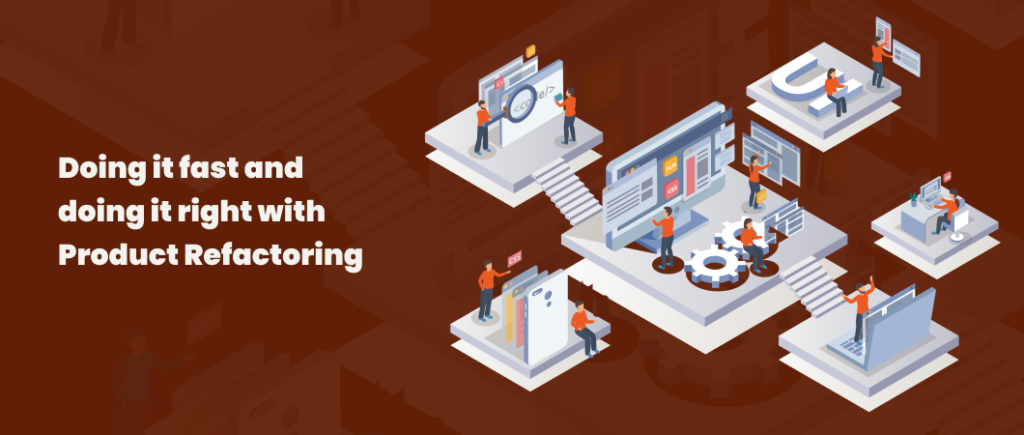Last updated on January 17th, 2023
Traditionally, enterprise software products have focused more on functionality than user-friendliness. Business users had little (or no) choice over the user experience of the applications that they could use. But this is no longer the case.
Customer expectations and market demands continue to evolve faster (particularly in the post-pandemic software world). Software development companies now create enterprise solutions as “customized and industry-specific” applications that need to adapt to changing market needs.
As a result, trends like “continuous development” or “continuous product evolution” are here to stay. Continuous improvement is now more of a mindset than a best practice. It’s noteworthy that the Agile manifesto prioritizes “individuals and interactions” over “processes and tools.”
Along those lines, it becomes imperative to understand what product refactoring is and what role it plays in the age of continuous product evolution. Let’s discuss.
What Is Product Refactoring?
Also known as code refactoring, product refactoring is essentially the process of changing application code without modifying its functionality. Typically, refactoring means making small (or incremental) changes to the code or its structure.
Why is product refactoring useful? Overall, product refactoring does not create a noticeable impact on the end-user. However, it can help application developers make code changes easily and add new features in the future.
What is the rationality behind implementing product refactoring? Essentially, it aims to make smaller code changes that do not majorly transform product behavior.
Code refactoring helps in improving application code by:
- Addressing any code dependencies or complexities
- Improving the maintenance and reusability of the code
- Cleaning the code, thus making it simpler and easy to understand
- Helping developers detect and fix any bugs or vulnerabilities in the product
How Is Product Refactoring Used in Software development?
A complex enterprise system does not necessarily have a good design in version 1.That emerges over time and use. This is the building principle of product refactoring in software development.
Product refactoring means constant code restructuring until it achieves an optimum product design. What is an optimum design? A code that fulfills the following criteria:
- Runs all the unit tests efficiently
- Meets the defined design requirements
- Does not contain any duplicate code or logic
- Contains a limited number of classes and methods
Among its benefits, product refactoring reduces the technical cost (or debt) of code. Developers can clean up any code efficiently than pay for major code errors later. Refactoring is also helpful in eliminating “code rot” arising from duplicate code, poor classifications, and other code-related discrepancies.
Here are additional reasons why refactoring is important in software development:
- Maintains a clean codebase
- Improves product performance
- Saves both development costs and time
- Reduces the technical debt
- Updates any outdated code
- Improves the product design
Can refactoring help with product iterations? Let’s discuss that next.
How Product Refactoring Helps in Product Iterations
Product refactoring is widely applicable in Agile and DevOps environments. In any Agile project, development teams work in short and quick iterative cycles, thus releasing the latest functionality in smaller chunks.
For products with continuous iterations, architects cannot design the product architecture in advance. If software companies spend too much time in the planning stage, they could find their product-related assumptions wrong later in the development phase.
In these scenarios, product refactoring provides a flexible and evolving architecture that architects can improve continuously. Through refactoring, developers can align and sync the code with the architecture.
How does refactoring compare with other methods like reengineering and code rewriting? Both product reengineering and rewriting require a dedicated project and team, thus accruing additional costs. Contrarily, refactoring is implemented as part of daily project work and does not require a dedicated project. Typically, code refactoring is executed at the end of each product iteration. Further, code iterations are implemented in response to user feedback and reviews.
Here are some of the best practices of product refactoring:
- Plan the refactoring project and its timeline
- Don’t refactor code without testing
- Change code incrementally in small chunks and check if the modified code works as expected
- Mitigate the risks by keeping refactoring small
- Don’t add a new feature or functionality amid product refactoring
- Include the QA and testing team in the product refactoring process
Conclusion
In an age of continuous product improvements and evolutions, refactoring is probably the most efficient way of improving any product code. Code refactoring is similar to “cleaning the home” from unnecessary clutter. This creates a better working environment for development teams and helps them make product changes with efficiency and discipline.
With Forgeahead, you are assured of the best product engineering, quality assurance, and technology consulting services that go beyond simply software development. Hire the best application expert partner for your next project. Speak to us today.



